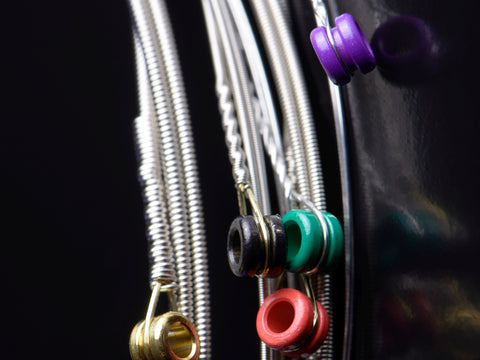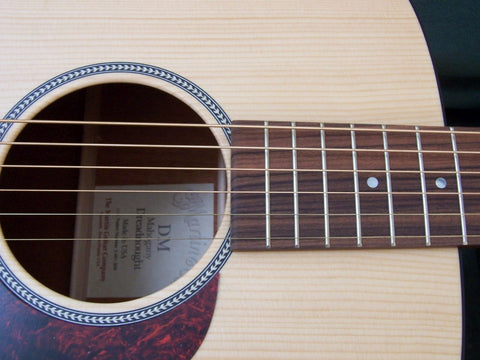Updated Nov 1st, 2024
How to Fix High Action on Acoustic Guitar
Lowering your action the right way on your acoustic guitar is a combination of planning and doing. Today we will cover all the right steps, before and after the actual action adjustment, with no surprises. There are many online articles and how-to videos on adjusting guitar action, but here we will go into proven detail and emphasize proper order of steps. This isn’t rocket science, but surprisingly many online sources are either leaving out steps or doing them out of order, which can have consequences later.
What is my experience? I have adjusted the action on countless guitars both for hire and for friends, over 3 decades and have run into just about every issue imaginable. Everyone loves my setups. I am confident this is the correct and best way to lower action whether it’s your acoustic, electric, or classical guitar. This is a two-part video below which details the process. So let’s get started!
How to Fix High Action on Acoustic Guitar Video Part 1
Step 1: Settle on the kind of guitar strings you want before adjusting action!
If you are considering changing the type of strings on your guitar, do this first before venturing into a costly setup or action adjustment. This is one of those forgotten steps! I’m talking more about changing the type, brand or gauge of strings rather than just simply swapping out your old strings for a new set of the exact same variety. Going from 9’s to 10’s, or Phosphor Bronze to 80/20 Bronze (or a totally different alloy) can affect your neck and action setup. String gauge equates to the size and more importantly the mass of each string. Heavier, more massive strings put more tension on the guitar neck because they require more tightness to get them up to pitch. Going from lighter to heavier strings will almost always affect your action and guitar neck, by raising the action. If you have a whammy or Floyd Rose tremolo system, changing string styles can wreak havoc on your bridge and fulcrum spring setup. This is also absolutely the case with some of the newer metal alloys that are available in guitar strings especially those that boast superior bending with a new metallic composition. Some alloys are more elastic meaning they stretch and bend easier than standard strings, so there may be a difference in the tension placed on your guitar neck resulting in different action. For these reasons it’s best to settle on a given string type before doing hardware and bridge adjustments! In years past I can’t tell you the number of times I’ve had clients bring back a guitar for another setup because they decided to change to different strings which messed up their action, then they tried to adjust it themselves and couldn’t get it right.
Lastly there should be no difference between brands if all else is equal with your strings, but why take the chance? If you want to switch brands I would do it first just to be safe. To summarize, if you’re just going from Martin Light Strings to another like-set of Martin Light Strings, there should be no issues!
Step 2: Check and adjust your neck angle (truss rod), then decide how low you'd like your action
You’ve heard the term “Check-up from the Neck-up!”, no doubt. Well it’s true here big time! Your neck needs to be aligned properly with the right truss rod adjustment before messing with the bridge or lowering string action. Some people say ‘adjust the neck after you adjust the string action’, and I totally disagree. Here's why: if you lower the action on your acoustic guitar permanently at the bridge, and then find out your neck still needs adjustment, you cannot go back and fix the bridge to compensate once you’ve shaved down the saddle. For this reason the neck should be checked and adjusted first. This is also true on electric guitars, do the neck first. Some guitars (classical and flamenco guitars) do not always have truss rods to adjust the neck angle. In this case just skip this step. Truss rods are often omitted on these guitars because nylon string guitars have thicker more sturdy necks, the lighter-weight nylon strings put much less tension on the guitar neck and are less likely to ever need a neck adjustment. Still, if you can get a classical guitar with a truss rod, it is a nice feature to have as sometimes these guitars still need neck angle adjustment. There are plenty of videos and articles online about how to adjust your guitar neck with a truss rod.

When evaluating string height, some people use a capo at the first fret and then check the action higher up the guitar at the 12 fret, etc. This simulates knowing the real action height while you are fretting notes. I’ve found this step doesn’t make a huge difference but you can do it if you like. Our method still lowers the action the correct, measured amount. What you should do is also check the action at the nut by the headstock. To do this, use a capo or simply fret the strings at the third fret, and examine the string height near the 1st fret. There should basically be nearly no movement of the strings when you press them down. This is covered in the first video, the purpose of this is to make sure your nut action is appropriately low before moving to the bridge adjustment. We don't go into detail on that here (which is an involved process and a separate tutorial) because more than 90% of the time you don’t need to adjust the nut action, and even if you do you can still lower the action at the bridge for a much better-playing guitar as outlined here.

At this point you want to move on and measure your guitar action at the 12th fret because we are getting closer to actually lowering it via the bridge. Decide what kind of action is right for you. Usually a 1-2mm adjustment is plenty unless your guitar is way out of adjustment. On cheaper acoustic guitars, it’s not uncommon for them to have mile-high action you could drive a car under. In this case follow the steps above of selecting strings and adjusting the neck FIRST. Once you’ve done this it’s likely you’re back to a 1-2 mm need of lower action at the 12th fret. If it requires more, that’s okay as long as your saddle can accommodate it. Using a fine ruler or caliper, measure the space between the strings and the fret at the 12th fret. There are also special guitar tools and spacers that will do this for you if you don’t want to use a ruler. Now you should be able to see the difference between the action on your guitar now and how you want it. Again, typically 1-2mm is a good rule of thumb to begin with in lowering. It’s important to mention that any adjustment done at the bridge will equate to HALF this distance at the 12th fret. This is just simple geometry. Lowering the action at the bridge 2mm will yield a net 1 mm reduction at the 12th fret. If you need to lower your action 2mm in playability at the 12th fret, expect to lower your bridge saddle up to 4 mm (now you may be starting to see the importance of measuring and doing all these steps in the proper order, so that we don’t have to go back and do it again).
Step 3: Remove the acoustic guitar saddle.
With your strings loosened but not removed, it’s time to remove your saddle. Most of the time this is easily done by hand or carefully using a pair of pliers to slide it out. Some acoustic guitar saddles will lift straight out with no need to slide off to the side.

With pliers cover the tips with masking tape to protect the wood near your guitar bridge. If you have an acoustic electric guitar, be careful removing it as there is likely a pickup transducer wire resting under the saddle. It is also important to note the bottom flatness of the existing saddle on acoustic electrics. This is very important to retain this exact flat shape if there is a pickup wire under your saddle. This flatness is what makes the strings resonate properly and keeps your guitar pickup working right and amplifying each string equally.
Next we will be marking the saddle with a ruler or straight edge to shade the area to be cut down. As in the above example, if you want an action decrease of 1mm at the 12th fret, you’ll need 2 mm marked and removed from the bottom of the white saddle.
This is also a good time to mention that you should not cut notches in your guitar bridge or saddle. Some people advise this to lower action but this is really a shortcut that could prove costly later. If your bridge didn’t come with notches from the guitar factory, do not make new notches and stick with the tried and true method shown here.
Step 4: On your mark…
With the saddle removed, it’s time to mark it as you’ll be cutting it down. This is an extremely important step and where many people go wrong. You don’t want to just start removing material on your saddle without measuring and having it clearly marked. Use a ruler or straight edge to mark and shade the area to remove with a pencil. As in the above example, if you want an action decrease of 1mm at the 12th fret, you’ll need to double it and remove 2 mm marked on the bottom of the white saddle. Measure on each side of the saddle and make a small mark, then join the mark across the saddle using a ruler. If your action was higher on the bass strings of your guitar than the treble, you can keep with this pattern intact as you mark your saddle for reduction.

Keep in mind millimeters is everything when it comes to guitar. Just like baseball is a game of inches, your guitar lives and dies in the world of millimeters! An action reduction of 1mm is often all that is needed to make a guitar go from bad to good playability. You can also adjust your action in steps if you aren’t sure how low to go or how low of action your guitar can handle without getting fret buzz. In this case start small, reductions of .5 or 1 mm at first, then tune it back up and play it.
Step 5: Time to Grind!
It’s time to shave down the guitar bridge saddle. Start slowly. Take all precautions and safety measures including gloves and eye goggles. If you are not a professional or tradesman experienced with power tools, then we don't recommend grinders or belt sanders due to the potential danger. It’s important you seek qualified help, as these types of tools can cause serious injury.
A safer method for the amateur is to use sandpaper, a sanding block, an electric sander, metal files, or a combination of these with the saddle safely secured in a vice. If you have spare saddles, it’s not a bad idea to practice on one first. Start slowly at first. Plastic saddles will respond much more quickly to filing or sanding than a bone or synthetic bone saddle. On finer guitars, the saddles will be of a harder material such as a simulated tusk (Tusq) or synthetic bone and these will take a little more time to machine down.

Be sure to retain the ‘square’ and flatness to the saddle as it is taken down. When all of the pencil marks are shaved off, stop. It's done. Take all safety precautions and hire a professional if using power tools.
Final Step: Reinstall the saddle, tune up, and test drive!
Reverse the removal steps above and carefully reinsert your saddle. Tune the guitar up to pitch with a tuner, and play it. It’s also a good idea to check all the frets and make sure you don’t have any new buzzing. Some people believe there is an ‘acceptable’ amount of string buzz, meaning you might gain a touch of fret buzz with lower action, but it shouldn’t be major or annoying nor do you want it coming through your amp. Fret buzz should be either totally non-existent or very minor. Enjoy your new-playing guitar with smooth, effortless action!
What about raising guitar action?
Raising your action height is usually easy, the same steps apply above about settling on strings and adjusting your neck beforehand. If it’s an electric guitar, there are tiny screws near the bridge that are loosened, which raise the height of your strings. Sometimes these are individual saddles for each string, but more commonly it’s just two screws on either side of your bridge. Make small adjustments each time, retune the guitar and play. If you have raised the action significantly, you should in turn adjust your pickup height so that you do not lose volume & gain.
On an acoustic, there is no way to raise the bridge saddle other than to place shims under it, or buy a new white saddle and resurface the entire thing top and bottom. When lowering action, it is usually only necessary to resurface the bottom. Shims work for some people, but it's better to start over if too much action has been removed on the current saddle. Shimming is a last resort to a resurfaced saddle, but resurfacing and crafting an entire saddle is a time consuming job. You may consider doing this if you are patient, or you can look into some pre-cut ones, or ask a luthier if they have any pre-cut saddles you can buy. Once installed, if the action is now too high you may have to lower it by resurfacing the bottom (not the top!) of the saddle as described in the video.
--
There you have it, all the right steps in the proper order to lower the action on your acoustic guitar. The steps are exactly the same on classical and flamenco guitars, just be aware that many classical and flamenco guitars do not have truss rods to adjust the neck, so you would skip that step. The steps are similar on an electric, but instead of resurfacing a saddle you make mechanical (and easily reversible!) adjustments at the bridge.
Whichever guitar you’re working on, keep it looking it’s best with the Player’s Kit Guitar Scratch Remover set. Our kits can forever remove many scratches and minor surface issues! It’s a great guitar care tool you’ll want in your toolbox, so why not pick up your kit today, and keep that new guitar of yours looking new for a long time to come. Thanks for reading! Keith @ GSR




After having measured the action with a capo on the third fret, do you leave the capo in place or remove it before measuring the distance between the string at the 12th fret?